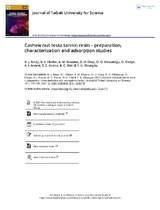| dc.contributor.author | Okafor, N.I | |
| dc.contributor.author | Nnaji, N.J | |
| dc.contributor.author | Ekwonu, A.M | |
| dc.contributor.author | Osuji, O.U | |
| dc.contributor.author | Okoye, O | |
| dc.contributor.author | Anozie, A.I | |
| dc.contributor.author | Anene, S.C | |
| dc.contributor.author | Ehiri, R.C | |
| dc.contributor.author | Onuegbu, T.U | |
| dc.contributor.author | Okwukogu, O.O | |
| dc.date.accessioned | 2021-09-13T11:27:23Z | |
| dc.date.available | 2021-09-13T11:27:23Z | |
| dc.date.issued | 2021-06 | |
| dc.identifier.uri | https://doi.org/10.1080/16583655.2021.1930717 | |
| dc.identifier.uri | http://hdl.handle.net/10566/6657 | |
| dc.description.abstract | Adsorption of metal ions and dyes from water by cashew nut testa tannin resin (CATAR) was studied and the effects of temperature, initial pH, initial concentration and time were investigated. Scanning electron microscopy (SEM) and infrared spectroscopy (FTIR) reveal effective adsorption processes. Kinetic studies show that CATAR adsorption is complex and thermodynamic parameters calculated reveal spontaneous and endothermic adsorption of studied pollutants onto CATAR. The use of CATAR as an alternative adsorbent is proposed considering that of simulated wastewaters gave excellent removal performances of 94.0% (Cd ions), 99.4% (Cu ions) and 97.1% (Pb ions) at pH of 6 and 303 K using amount of CATAR. Removal performances obtained for simulated dye wastewaters using CATAR at similar conditions for removal of metal ions gave 71.1%, 79.2% and 86.6%, respectively for crystal violet, methylene blue and malachite green. | en_US |
| dc.language.iso | en | en_US |
| dc.publisher | Journal of Taibah University for Science | en_US |
| dc.subject | Adsorption | en_US |
| dc.subject | industrial effluents | en_US |
| dc.subject | isotherms | en_US |
| dc.subject | kinetics | en_US |
| dc.subject | wastewaters | en_US |
| dc.title | Cashew nut testa tannin resin – preparation, characterization and adsorption studies | en_US |
| dc.type | Article | en_US |

